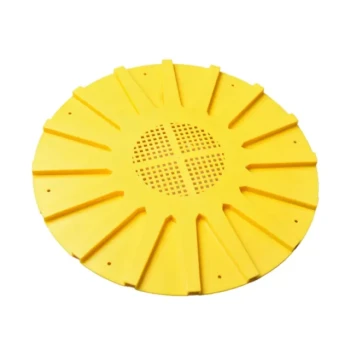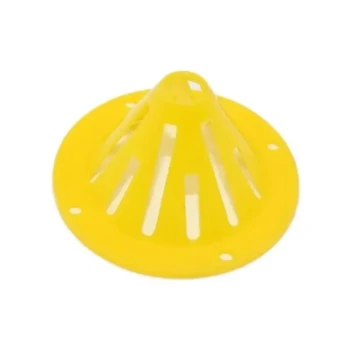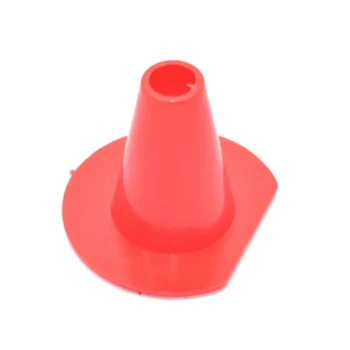In beekeeping, a queen excluder serves one primary function: it is a selective barrier placed inside the hive to confine the queen bee to the brood chamber. This grid allows the smaller worker bees to pass through to the upper honey storage areas (supers), but its gaps are too narrow for the larger queen. This ensures she cannot lay eggs in the frames designated for honey collection.
A queen excluder is a tool for hive management that guarantees brood-free honey for an easier harvest. However, its use is a significant strategic choice, as it introduces a physical barrier that can alter the natural workflow and productivity of the colony.
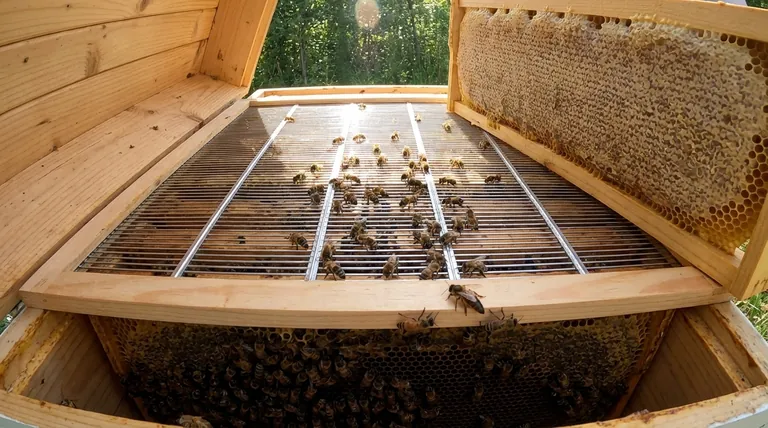
How a Queen Excluder Works
A queen excluder’s design is simple, relying on a fundamental difference in size between members of the colony. It is typically placed between the uppermost brood box and the first honey super.
A Matter of Size
The gaps in a metal or plastic excluder are precisely engineered, usually between 4.1 and 4.4 millimeters.
This sizing allows smaller worker bees to move freely between the broodnest and the honey supers. However, the queen bee and the male drones are too large to fit through, effectively trapping them in the lower portion of the hive.
The Hive's New Layout
By installing an excluder, the beekeeper creates a definitive boundary within the hive.
The lower boxes become the dedicated "nursery" or broodnest, where the queen lays eggs and the colony raises new bees. The upper boxes become a dedicated "pantry" or honey supers, used exclusively for storing surplus honey.
The Core Problem It Solves: Brood in the Honey
Without an excluder, the queen is free to roam the entire hive. While this is natural, it can create significant challenges for the beekeeper, particularly during honey harvesting.
Ensuring "Clean" Honey
The primary benefit of an excluder is preventing eggs, larvae, and pupae from being mixed in with the honey you plan to harvest.
Frames containing brood are difficult to extract honey from without damaging the developing bees and potentially contaminating the final product.
Streamlining the Harvest
For beekeepers, especially those with multiple hives, an excluder vastly simplifies the harvesting process.
When you pull a frame from a honey super above an excluder, you can be confident it contains only honey and wax. This eliminates the need to carefully inspect each frame for brood before placing it in a honey extractor.
Predictable Colony Management
Using an excluder provides a high degree of organization. During hive inspections, you know exactly where to look for the queen and assess the health of the broodnest. This makes finding the queen and evaluating colony strength a much faster task.
Understanding the Trade-offs
Despite its benefits, the queen excluder is a controversial tool, and many experienced beekeepers choose not to use one. Understanding the downsides is crucial for making an informed decision.
The "Honey Barrier" Effect
The most common argument against excluders is that they can reduce honey production. The barrier, though passable for workers, may slow their movement into the supers.
Some beekeepers believe this slight hesitation, multiplied across thousands of trips, results in less honey being stored over the season.
Increased Swarm Pressure
Confining the queen to a limited area can cause the broodnest to become congested with honey and pollen more quickly.
This condition, known as being "honey bound," is a major trigger for the colony to begin swarm preparations. Using an excluder requires the beekeeper to be more diligent in managing space in the brood chamber to prevent swarming.
Wear and Tear on Workers
There is a belief that repeatedly squeezing through the excluder's gaps can fray and damage the delicate wings of worker bees. This physical toll could shorten their lifespan and reduce the foraging force of the colony over time.
Making the Right Choice for Your Hive
Your decision to use a queen excluder should be based on your specific goals and hive management philosophy. There is no single correct answer for every beekeeper.
- If your primary focus is streamlined, efficient honey harvesting: Use a queen excluder to guarantee your honey supers remain completely free of brood.
- If your primary focus is maximizing honey production with minimal interference: Consider forgoing the excluder, but be prepared for a more complex and careful harvest.
- If you are a new beekeeper seeking predictability: An excluder can simplify hive inspections and colony management by creating a clearly defined broodnest.
Ultimately, the queen excluder is a tool for control, and you must weigh the benefits of that control against its potential impact on the hive's natural workflow.
Summary Table:
| Function | Benefit for Beekeeper | Key Consideration |
|---|---|---|
| Confines queen to brood chamber | Guarantees brood-free honey supers | Can potentially reduce honey yield |
| Allows worker bees to pass | Simplifies the honey harvesting process | May increase swarm pressure if brood nest is crowded |
| Organizes hive layout | Makes hive inspections and finding the queen easier | Some believe it causes wear on worker bees |
Ready to optimize your honey harvest?
Whether you manage a few hives or a large commercial apiary, the right equipment is key to efficiency and productivity. HONESTBEE supplies durable, precision-engineered beekeeping supplies and equipment—including queen excluders—to commercial apiaries and beekeeping equipment distributors through our wholesale-focused operations.
Let us help you make the best choice for your operation. Contact our expert team today to discuss your needs and discover how our products can support your success.
Visual Guide
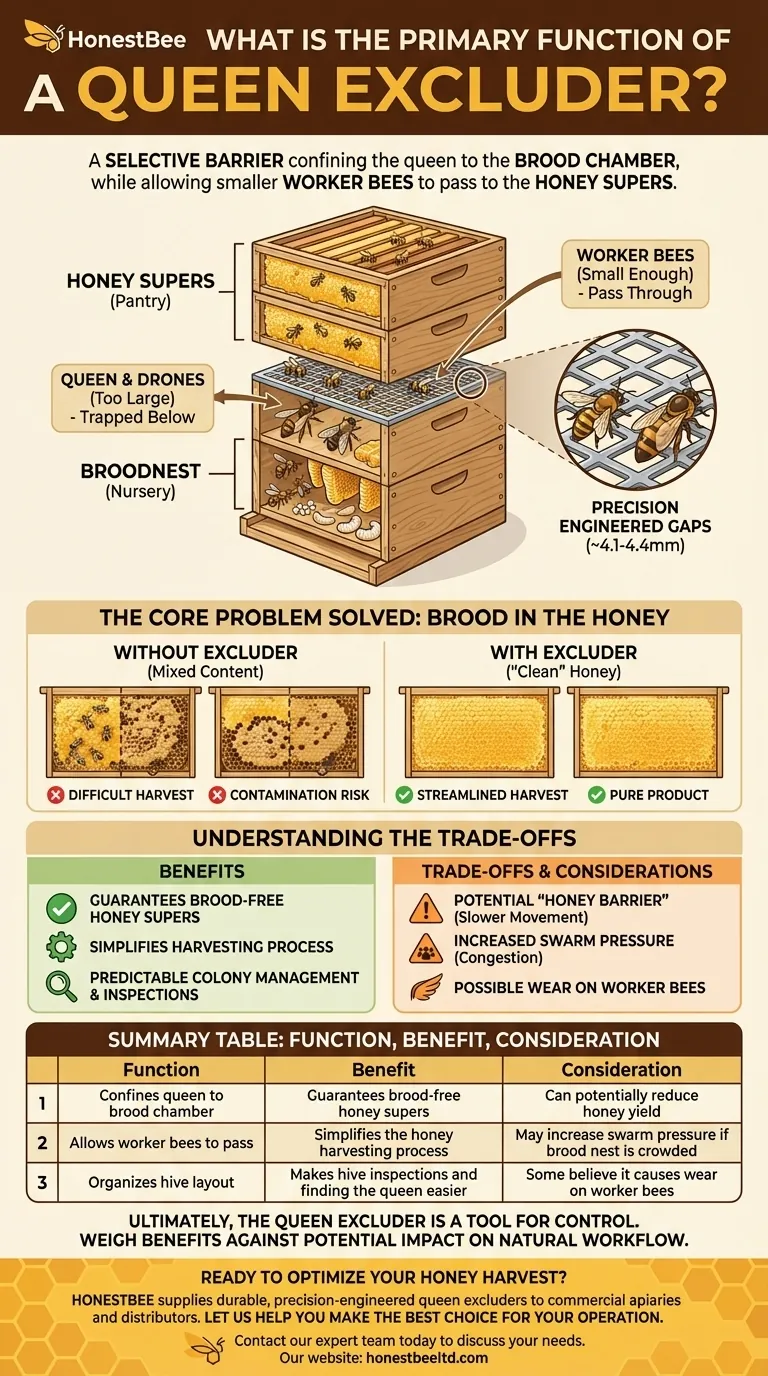
Related Products
- Premium Wood Framed Metal Wire Queen Bee Excluder
- Professional Plastic Queen Excluder for Modern Beekeeping
- High Performance Plastic Queen Excluder for Beekeeping and Apiary Management
- High-Efficiency Diamond Maze Bee Escape for Clearing Supers
- Durable 16 Way Circular Bee Escape for Efficient Honey Harvesting
People Also Ask
- What are the advantages of using a queen excluder? Maximize Honey Yield & Hive Control
- When to put queen excluder on hive? Key Timing for Maximum Honey Production
- What considerations should a beekeeper take into account when deciding whether to use an excluder?
- Can a queen get through a queen excluder? A Guide to Preventing Hive Failures
- Where should a queen excluder be placed in a beehive? The Key to Hive Organization




